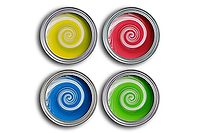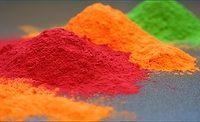“Color possesses me. I don’t have to pursue it. It will possess me always, I know it.” Many will associate and sympathise with the position of the Swiss Expressionist artist Paul Klee. For many years, designers, artists, scientists and psycho-analysts have debated the impact color has on our lives. Despite a lack of empirical evidence, it is clear that colors have the power to create a lasting impact on mind, body and emotions. They can make us feel happy or sad. They can make us hungry. They can make us relax. They can affect our energy levels.
And because color stirs up human emotions, it allows us an opinion; we all know which colors we like and don’t like, and most of us have a favourite one. (For me, it is hot, burnt orange: such a strong, lively and high-impact color that really has something to say about the world.)
Our eyes are much quicker and stronger in getting information than our ears. And when we look at something, color speaks first (followed by shape) giving it a unique ability to infinitely change the way an object – whether it be a car, a bicycle, a bottle of beer or a building – looks and feels. It’s no wonder brand managers pay such close attention to product coloring, knowing all too well the impact a certain shade of red, blue or green might have on consumer purchasing decisions.
But what impact might color have on the towns and cities we live, play and work in? Can color be used to make our public spaces more human and socially engaging?
An experiment in the town of Sortland in the north of Norway has proved one thing: color can increase tourism. Keen to encourage more Northern Lights-seeking tourists to stop over and spend money on their way out to the northern peninsula, the town’s public authority and local companies came up with a novel way of drumming up business. They decided to paint their town’s buildings blue.
It wasn’t an easy task, and through my role as design manager at AkzoNobel, I spent time in the town, giving lectures about marketing and color to sceptical business owners, explaining how the town’s new-found notoriety would boost economic success. We developed two palettes of warm and cold blues and transformed the town’s look and feel.
Today, Sortland is world famous. People stop to buy t-shirts and beer. It worked.
Of course, creating places that people want to visit is not all about creating more colorful spaces. Often, it’s about emulating the endless color variations that occur in nature. Think of leaves on a tree, or a rolling river. There is no material in nature that has just one color. The same effect can be applied on our city streets. For example, making use of 10 different yellows and beiges – rather than bold, strong colors – can make things look bigger, taller, smaller or shorter, and more fabulous.
And the same techniques can be used to reduce crime and improve safety. In Stockholm’s architecturally famous Stortorget Square, we were asked to design a color scheme that would offer a new lease of life to a space commonly littered with drugs and homelessness. We created a palette of white and three shades of grey. Today, it looks well-lit and well-cared for. Crime is down and the drugs are almost gone. Even thugs have a problem with ruining things that are beautiful.
A similar project is going on at the Swedish capital’s Science City, where Sony and Ericsson have their regional headquarters, to improve a seemingly unsafe underground transport terminal. The added issue here is one of navigation: people struggle to find their way around. Color is offering a solution as not only a provider of better light (and therefore, safety), but also in a functional capacity, helping to give direction and sense of place for bewildered visitors.
Take a city like Glasgow, the Scottish host of last year’s Commonwealth Games. With thehighest homicide rate in Western Europe, an average life expectancy for males of just 54 (not helped by drug-related deaths jumping 95% since 1997) and the highest suicide rate in the UK, many of its residents are mired in poverty, unemployment and a lack of educational opportunities. Meanwhile, as Glasgow’s Evening Times recently reported, there has been an “unprecedented” surge in abusive and threatening behaviour, offensive graffiti, Nazi salutes and foul language aimed at the city’s Jewish community in the last six months, prompting fears of a new wave of religious hate-crime.
How might color be used to help alleviate some of these problems, many of which are most prevalent within inner city environments?
Our cities continue to grow. By 2050, 70% of the nine billion people living on the planet will live in our urban environments. To help meet this demand, AkzoNobel’s Human Cities initiative is designed to help find ways of making our cities more inspiring, energizing and vibrant. Color is one of six important strands to the program, as we look to harness the transformative power of color to bring public spaces to life while ensuring they stay true to their origins.
Having spent my life with color – a life that began with summer vacations working in my grandfather’s paint shop – I’m still amazed by its power to alter the senses and influence our feelings. Why do we love to walk the Champs-Élysées in Paris? Why do we adore traversing the cobblestones of Florence? Or wandering the harbour in Portofino? Yes, the architecture, the city layout, the food, the art and the smells play a role. But it is the color that makes us keep coming back.
For more information about the AkzoNobel Human Cities initiative, visit www.akzonobel.com/aboutus/human_cities/.





Report Abusive Comment